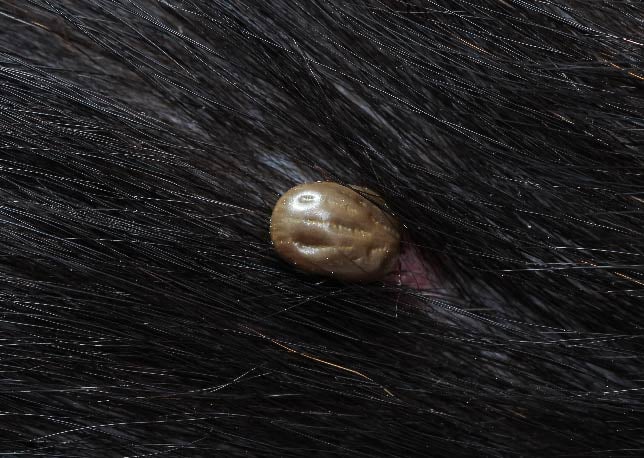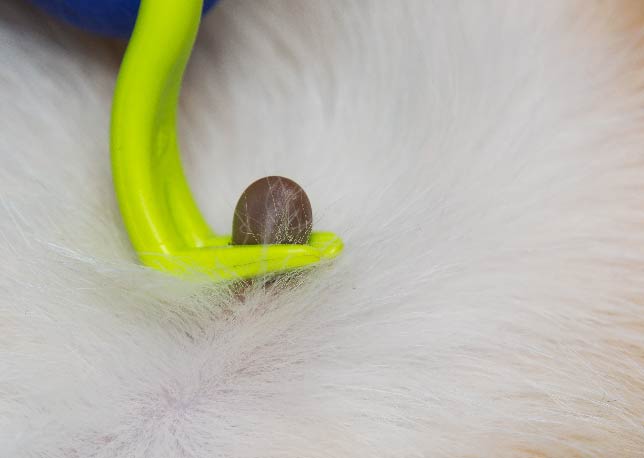23rd March 2022
Ticks on cats – identification & treatment
As a cat owner, you’re likely to find a tick or two in your feline’s lifetime. So, it's important to know how to properly remove them and the risks they carry.
Ticks are nasty little parasites that can spread infectious diseases to us and our cats. With several different species in the UK looking for the perfect feeding ground, you might find your feline friend coming home with these unpleasant hitchhikers in their fur.
Here’s everything you need to know about these arachnids, the diseases they carry, and how to help keep your cat safe from both…
What do ticks look like?
Ticks vary in shape, colour, and size – but, generally, they’re very small until they latch onto a host and start feeding. They’re usually brown in colour before they start feeding, then change to a pearly grey once they’re plump, rounded, and engorged (full) with their host’s blood.

When are ticks active?
Although they’re most active from March to October, ticks are around in the winter months, too.
Because ticks are at risk of drying out, they’re typically found in long grass, rough upland, and woodland areas – which tend to be damp and have high humidity. In other words, all the places a cat might explore during a hunt for a quick snack!
How do ticks get on to your cat?
Ticks rest on the tips of grasses and shrubs, waiting for their perfect host.
Since they don’t fly or jump, ticks will either climb or drop onto your cat’s coat when they brush past. Then, the tick will attach themselves quickly or crawl through your cat’s fur to look for warmer areas before digging in.
Where do ticks bite?
Once your cat returns home from their outside adventures, it’s a good idea to check them over for ticks.
It can be quite hard to find ticks at first, as your feline friend might not show any signs of discomfort – even if they’re being fed from. But checking your cat can help you find a tick before the situation turns into something more serious.
Ticks can be found anywhere on your cat’s body, but they particularly like to attach themselves around:
- Ears.
- Head.
- Neck.
- Groin.
- Armpits.
- Feet (between the toes).
How do you remove a tick from a cat?
The trick to removing a tick is in the method. It’s important to get the entire tick out, head and all, to prevent infection and the spread of diseases.
Step 1 – Part your cat’s fur so you can see the tick.
Step 2 – Using a tick removal tool, place the hook around the base of the tick; grasping the tick as close to the skin as possible.
Step 3 – Twist the tick hook and lever it upwards, so the tick detaches from your cat’s body.
Step 4 – Don’t pull or squeeze the tick’s body, as this can leave the head parts embedded in the skin. Leaving the tick’s head can cause infection and lead to the tick regurgitating its stomach contents into the bite wound, spreading disease.
You should always use a tick removal tool* that helps you remove the tick whole, so there are no parts left in your cat.

Do not use tweezers, petroleum jelly, chemicals, or other means to take off the tick, as this can result in infection, disease spread, and discomfort for your cat.
Lyme disease, ticks and cats
Unfortunately, these nasty pests will bite and feed on your cat for a few days before dropping off once they've had enough. During this time, it's possible the tick could transmit a disease to your feline friend.
One of the diseases spread by ticks is Lyme disease – a serious bacterial infection. Despite being uncommon in cats in the UK, it’s still important to be able to recognise the signs of Lyme disease, just in case.
Symptoms may include:
- Joint pain, lameness, or limping (this can shift to different legs, too).
- Enlarged lymph nodes (tiny, bean-shaped organs that collect fluid to filter out bacteria, viruses, or other harmful cells before returning cleaned fluid to the bloodstream).
- Loss of appetite.
- Fever.
- Discomfort or pain.
In humans infected by Lyme disease, a red “bullseye” rash around the bite site may be found, but this is not seen frequently in pets.
Keep an eye out for any unusual marks, symptoms, or behaviour in your cat, since signs might not appear for a few weeks after a tick bite.
How to prevent Lyme disease
Like most things, prevention is better than a cure when it comes to ticks.
Luckily, it’s easy enough to protect your cat from ticks and other parasites that might take a liking to them. With no vaccines available to stop some of the diseases carried by these pests, it’s important to learn the best tick prevention methods:
- Speak to your vet about tick prevention products. By speaking to your vet, you’ll be able to learn which product is safe and effective for your cat. Tick prevention products reduce the risk of your feline friend bringing home one of these pesky critters.
- Remember: Never use dog flea or tick prevention products on cats, as they are toxic to felines and can be fatal.
- Check your kitty for ticks every day, especially if they’ve been out and about or they’ve just come in from a wander. If you find a tick, remove it immediately using a tick hook, as described above.
There are many risks and dangers for our feline friends, so it’s down to us to keep our cats as safe as we can. If you’d like to identify the number of tick threats in your local area, visit the UK Health Security Agency Tick Distribution map.
*This webpage uses affiliate links for VioVet – which means that if you buy something through these links, Animal Friends may earn a commission.
Looking for more cat advice?
We’ve written some handy cat advice guides, to help you unlock the secrets of your mysterious moggy.
Need cat insurance?
Cat insurance can help cover the cost of veterinary treatment if your cat gets injured or falls ill.
We know pets
Our pets are part of the family. To achieve our vision of a better future for pets everywhere, we work with our partners, vets, and other veterinary professionals who are pioneering the latest advancements in animal care. Our campaigns, articles, and events are crafted to support, educate, and celebrate pet owners, while our policies are designed to provide peace of mind at an affordable price.
Yet our policies don’t just protect against the unexpected – they have purpose, too.
Since we were founded over 25 years ago, we've provided industry-leading policies that protect the nation’s pets, while also making a difference to animal welfare and our planet. Thanks to you, our policyholders, we've donated over £9 million to more than 830 animal welfare charities and conservancies, helping to support vulnerable pets and wildlife around the world.
We’re proud to be wildly different. Are you?
